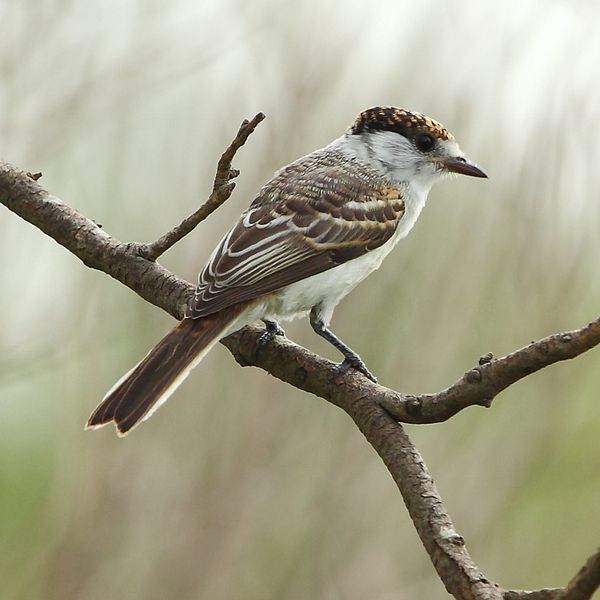
That’s a question you’ve probably never asked yourself. There’s a decent chance you’ve never even heard of it before. I hadn’t until a little over a month ago when while flicking through one of my volumes of the Handbook of the Birds of the World (HBW) I came across it. I was looking for a new project to write about on Wikipedia, something unusual, and this species appealed for reasons I can’t quite define. It was both mysterious and plain.

Juvenile White-naped Xenopsaris by Hector Bottai (Creative Commons).
The White-naped Xenopsaris is a member of the Tityra family (Tityridae), a newish family of mostly South American birds carved from various oddball birds formerly lumped with the manakins, the tyrant-flycatchers and the cotingas. Birds like the tityras, the becards and the purpletufts. The White-naped Xenopsaris (or white-naped xenopsaris, as the bird became known on Wikipedia after the aggressive grammarians had their way with bird names) is not a well known bird. It is apparently uncommon across most of its wide range in the shrublands of South America, little noticed and little noted, and sources are pretty thin, as they are for many birds in places like South America.
But it did intrigue me and I rooted around for every source I could find, the product of which you can see in the link above. From a three line stub it now has a full article. One mystery was its movements. The migration within South America of local birds, as opposed to North American visitors, is poorly understood for many birds (as in Africa). A couple of articles suggested it may be migratory, in the southern part of its range, but then I found one recent Argentine article that stated categorically that it was in one site. I wondered about whether that could be extrapolated for the region (Santa Fe) or even the whole southern part of its range (Argentina and Uruguay).
It then occurred to me that I could use eBird data to check. eBird has a range of data exploration tools that, to my mind, exist help birders bird. Nothing wrong with that. But here I could use data collected over ten years (or more) to actually see presence and frequency data for a given species in an area, to literally answer the question to which the HBW had been uncertain over. And here’s what I found for Argentina…
And for Santa Fe
That’s a pretty powerful argument for the species being migratory, and also leaving Santa Fe (near Buenos Aires) in March, sooner than northern areas that linger till April (I assume, I would need to poke around in the data more).
Having had the aha moment I was then “okay now what?” I can’t just put this into Wikipedia – it’s original research. Wikipedia doesn’t allow that lest it be overrun with all manner of research proving feminism causes cancer. Citizen science needs an outlet to peer review and publish small findings like this, to allow them to be known and push back ignorance on so many species, but also subject them to a measure of review. Handbook of the Birds of the World Alive, the HBW’s online version (worth a subscription by the way) is perhaps leading the way on this with a Ornithological Notes section, perhaps this is the venue to spread these kinds of findings. At any rate let it be known to all readers here that the White-naped Xenopsaris is (probably) migratory in Argentina! Maybe.















Veey cool, I have actually wondered about the movements of this species!
Cornell’s Neotropical Birds website would be a great place to publish this kind of information. The article for White-naped Xenopsaris is incomplete, and needs an author.
http://neotropical.birds.cornell.edu/portal/species/overview?p_p_spp=485836
Thanks Chuck, that’s an interesting option.
This would be a publishable standalone paper; Alex Lees has published several similar findings:
http://onlinelibrary.wiley.com/doi/10.1111/jofo.12159/abstract
http://onlinelibrary.wiley.com/doi/10.1111/ibi.12207/abstract